Can You Van Life With A Cat? 8 Essentials and Tips To Consider
Living in a van with a dog is pretty common, but what about the cat owners?
Van life is no walk in the park, especially if you’re trying to also maintain a happy family or household.
Cats come with their own set of challenges that van life dog owners don’t have to worry about. Litter boxes, less public acceptance, and their adventurous spirit just to name a few.
Living in a car with a cat can be a challenge, but if you take the right steps, it can be a rewarding experience for you and your fluffy friend.
Packing list for a van life cat
- Get microchips and vaccinations before you leave
- Personalized cat collar
- Cat harness and leash
- Collapsible, non-slip food and water bowls
- Airtight food storage container
- Enclosed litter box
- Eco-friendly cat litter
- Remote temperature monitor
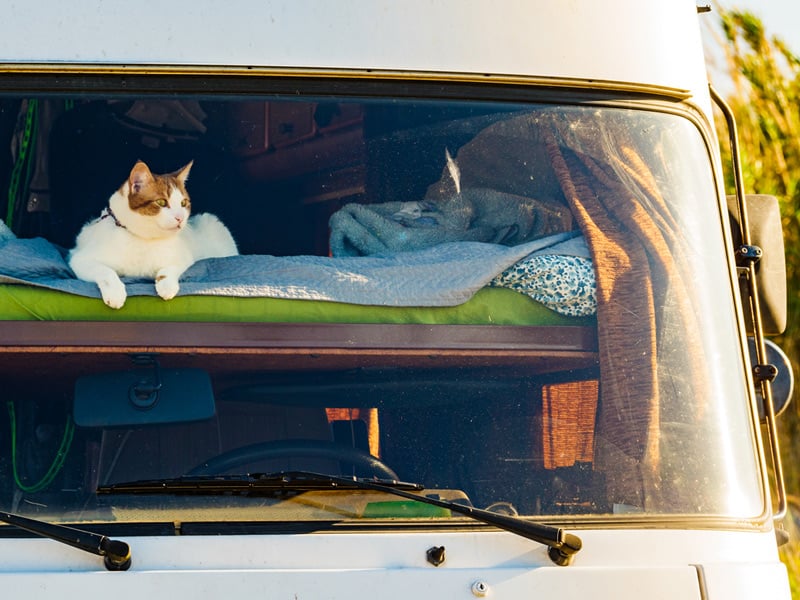
Before van life with a cat: get your shots up to date!
Before setting off on your new life, take a trip to the vet office and make sure your kitty is up to date on all of their vaccinations.
Get copies off all of the paperwork to bring along on your travels. This is going to be important if you decide to cross the border into Canada, or drop your cat off at a kitty day camp in the city.
Get your cat chipped
With all of the traveling your going to be doing, make sure to get your cat chipped!
There’s going to be a lot of new adventures in store for your furry friend and a new event might cause them to wander.
Along with getting your cat chipped, get a personalized collar on your kitty that includes a phone number to make it easy to reach you in the event that your cat wanders too far from their comfort zone.
Practice Travel
You don’t want van life to be your cat’s first trip in the car. Try some smaller vacations like weekend trips and even longer car rides to help them get used to the feeling of a moving vehicle.
Make the trip a positive thing by giving your cat treats along the way and special walks as you harness train.
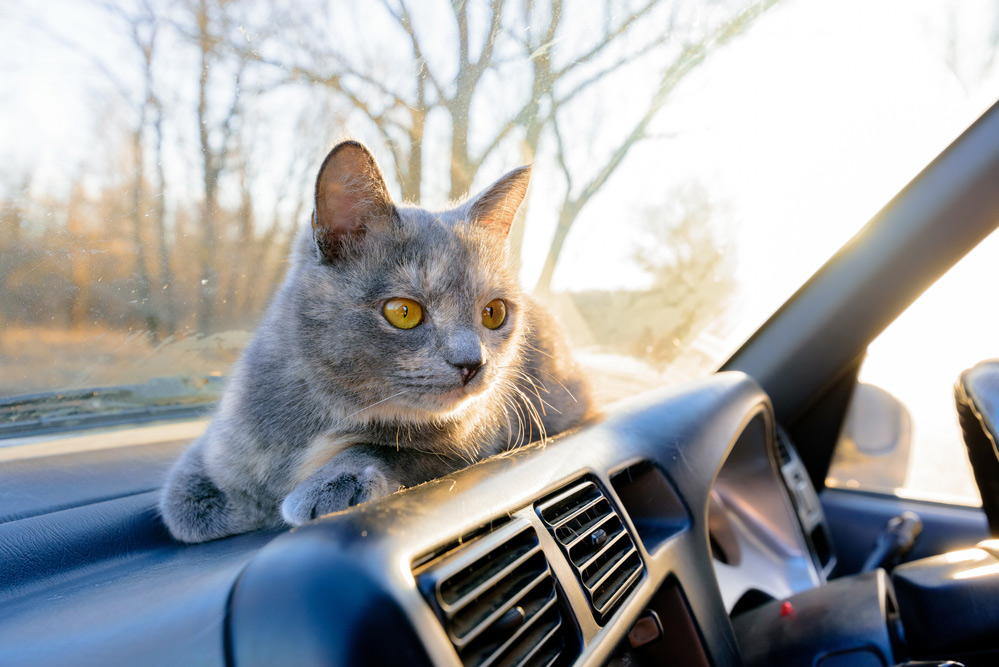
Leash Training Your Cat For Van Life
Contrary to popular belief, keeping your cat safe and healthy doesn’t necessarily mean keeping them indoors.
Cats are natural-born hunters and love being outdoors, so there’s really no need to keep them inside if you have a safe outdoor space for them.
Just like dogs, leash training is essential in order to keep your best friend safe.
It’s vital that you get your cat comfortable with wearing a leash before hitting the road. Practice at home for several hours per day and take them on frequent walks so they get used to it.
Most cats love taking the lead and exploring the outdoors, but you need to make sure they are supervised at all times.
To keep them comfortable consider using a cat harness, and allowing for an extra long leash.
Harness training your cat can take several weeks, so make sure you give yourself enough time to do it.
At the campsite
Once you’ve posted up at the campsite, swing those car doors open and let your kitty roam!
You can tie your leash to the outside of the camper van so your cat can chase after bugs and roll around in the grass.
Keep your eye out for other animals or knots in the leash.
Overtime your cat will begin to think of the area around your RV as their little safe space and enjoy laying in the sun just as much as inside.
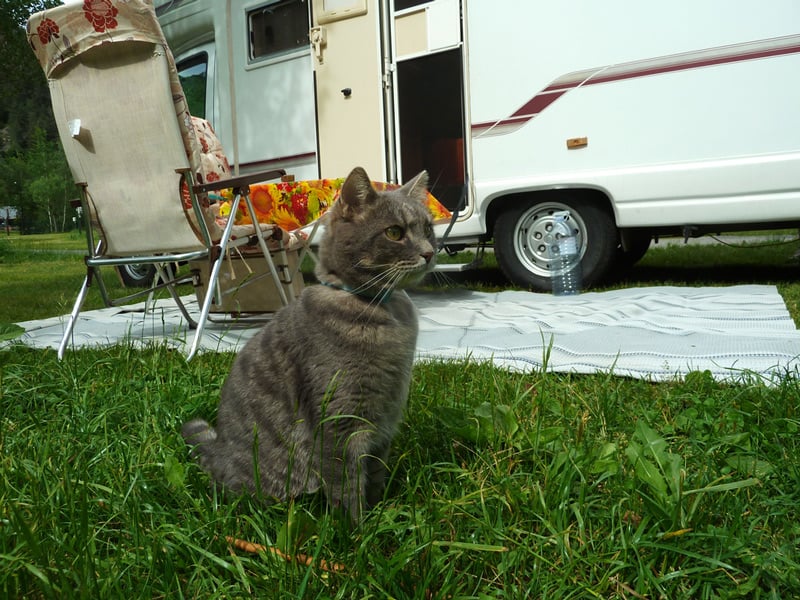
Temperature Control
Unfortunately, there aren’t as many public spaces that cats are accepted in compared to dogs.
When you’re traveling with a dog, you can often find trails in the National Parks, beaches, and even restaurants that allow you to bring your pet along.
For the most part, cats are not as welcomed inside–even when we’re talking about pet friendly places.
That makes temperature control in your camper van even more important.
Keeping your cat cool in a camper van
Most van lifers are not traveling with an air conditioning unit. So you need to get creative in the hot weather.
Fortunately, there are a lot of little tricks that you can do to keep the van cool for long periods of time.
Open all the doors: airflow is the easiest way to cool off your camper on the hot days. If you’re able to open up the back doors and side doors you can hopefully get a nice breeze through the living space.
Get a vent fan: On the windless days, a vent fan is essential for creating a comfortable breeze.
Park in the shade: Your vehicle stays significantly cooler when parked in the shade. Duh! But if you’re trying to collect all of that precious sunlight for your solar panels, maybe put your pet in the shade instead.
Keep the cat outside: During the day when the sun is shining bright, chances are good that the temperature outside is going to be much more comfortable than inside.
Cats tend to enjoy it outdoors as well since there is more to look at and they have room to stretch out. So lay out your cat’s favorite blanket and let them relax under the trees.
Cool your cat, not your van: When you need to run into the store or can’t allow your cat out for whatever reason, then focus on cooling the cat, not the van.
Keep ice packs, cooling pads, and plenty of water around for your furry friend.
- Remote temperature, humidity and heat index monitoring
- Designed for vehicles and motorhomes
- Get text alerts when conditions are dangerous
Keep track of the temperature with a remote monitor
You should never leave your cat in car for hours at a time even if it doesn’t feel that hot out.
Vehicles heat up deceivingly quickly.
And even if you’ve got comfort items for your cat, you never know who is going to walk by and just assume that your cat has been abandoned.
If you do any sort of long term travel with your pet, it’s worth investing in a remote temperature monitor.
Products like Waggle are designed to send text alerts to your phone when the temperature or humidity gets dangerously hot (or cold).
You can use them to check the inside temperature of your motorhome while you’re away from the vehicle like in a store or restaurant.
If anything, the peace of mind is worth the price, even if you’re the most careful planner.
Keeping your cat warm on cold days
Luckily, keeping a cat warm can be a lot easier than keeping it cool. Our favorite way to warm your cat is with some snuggles!
But if you don’t have time to lay next to your cat all day, there are a few other things you can do to keep him warm.
Insulate your van: Your camper van will retain more heat if it’s properly insulated. Polyiso and extruded polystyrene are great materials to insulate your van quickly.
If you have a bigger budget consider spray foam or wool insulation for the most effective solution.
Load up on blankets: An easier and more temporary method is simply providing lots of thick, comfortable blankets for your furry friend.
Install a heater: Camper van heaters are an excellent way to keep your small space warm. Remember: you should never leave a pet unattended in a camper with a heater running! We have unfortunately read some sad stories about pets knocking over heaters or getting burned.
Heat up some water: One of our favorite lesser-known methods of keeping your cat cozy is the hot water bottle method. This trick takes very little energy and can keep your cat extremely warm. Simply heat up some water using a stovetop or Jetboil and carefully pour it into a water bottle.
Then you can wrap your water bottle in a light blanket and set it next to your kitty. Most cats absolutely love the warmth of a hot towel to lay next to.
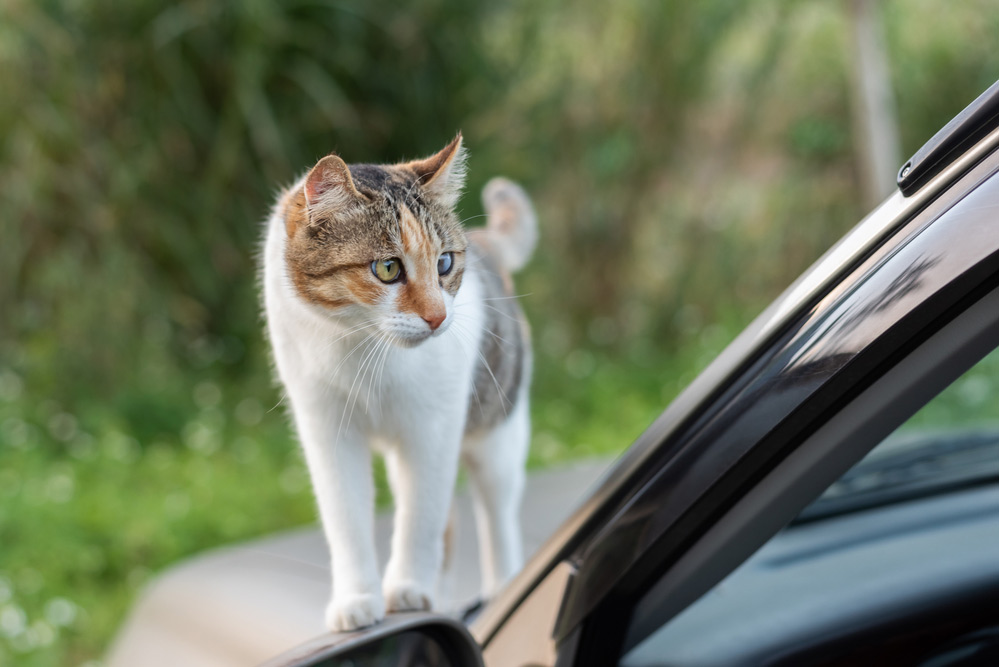
Avoid Nosy Neighbors
You know your van, and your cat better than anyone. One of the biggest fears that van lifers have when they leave their pet alone in a vehicle is that a concerned citizen might come along and try to “rescue” your animal.
One trick the we’ve found particularly helpful with our dog is to leave a note on the windshield that says:
“Hello, I’m ______! I have food, water, and a vent fan running and I’m very comfortable. If you are in anyway concerned, please don’t hesitate to contact my owners XXX-XXXX”
This way, you’ll get a text message instead of a break-in if someone is concerned about your pet.
Where do you put a van life cat litter box?
Now onto the important questions, what to do with the litter box!
It’s important that your cat has a safe space to do their duty. Many cats become territorial creatures over their litter box so you want to find a permanent space where it won’t be moved around.
Try to find a place to set your litter box where it won’t slide around in a moving vehicle. A litter tray with high sides is ideal.
Create a small cubby so your cat won’t kick around or play in their litter box. Since there’s such limited space in a van you really want to avoid messy litter getting kicked into your sleeping quarters!
Underneath the bed or right on the floor next to the passenger seat are common litter box locations. Just make sure to empty your litter before going to bed!
Use a dual-purpose litter box
Many van lifers prefer a dual-purpose cat box that can be used for seating and litter control. This is a great way to save space and give your cat the privacy that she needs.
Does having a litter box in a van smell?
No, fortunately as long as you are emptying the litter box on a frequent basis it should not stink up your car.
How often should you scoop out cat litter for van life?
Aim to clean out your cat’s litter box at least once a day. If it’s especially muggy in the van you should scoop it out twice.
Tips for keeping cat litter box smell down
- Scoop your litter box frequently; ideally once or twice per day.
- Store your litter box so that it’s easy to access.
- Use pine pellets rather than clay litter to reduce smells.
- Keep your car as cool and dry as possible.
Litter storage
Food and litter take up quite a bit of space in a tiny home. Most cat owners will keep the litter stored in the original bag that it came in.
This is one of the reasons that we recommend organic materials like pine pellets rather than clay litter. Not only is it good for the environment, but it smells nicer and it’s easy to dispose.
Cat Food Storage
When it comes to storing cat food, you’ll want a container that seals completely so it doesn’t attract any rodents or other creatures like bears!
This will keep the smell down and also make it easier to pour in proper proportions.
Food and water bowls
Non-slip food and water bowls are the best when it comes to constant travel. That way the bowls won’t slip around on your floor or get knocked out of the way when you’re moving around in such a tiny space.
Collapsible bowls are also a great way to save space and they’re also perfectly portable.
Lightweight, collapsible bowls are easy to take on hikes and stuff into your cat backpack if you decide to hit the trails.
Essentials for your van life cat
In order for your cat to have the best life, you need to create a comfortable environment where they feel safe and in control.
Create your cat’s own little space that includes a littler box, scratching board, and non-slip bowls.
Keep their food and water bowls in the same area every day so they know what to expect.
Have comfort items like blankets and cat toys around for entertainment.
Never leave your cat in a van or RV that is too hot or too cold.
The biggest concern you should have about traveling with a cat is the temperature inside the vehicle. Consider purchasing a temperature monitor to keep track of the vehicle conditions.
Make sure to get outside and take your cat for daily walks. They are curious creatures and will love to explore the new environment as much as you!
Re-evaluate every few months to make sure that your cat is comfortable and happy.

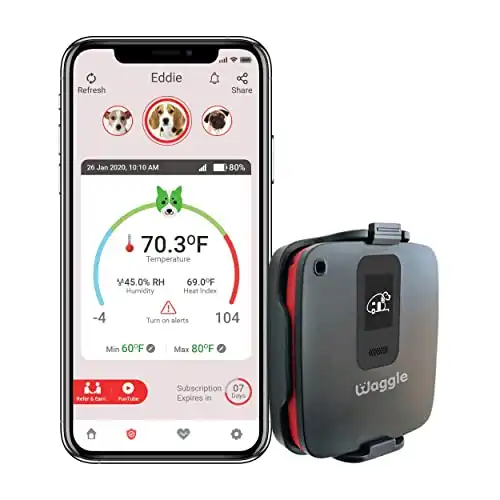
This Post Has 0 Comments